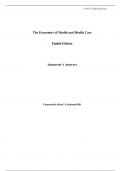Exam (elaborations)
Solution Manual for The Economics of Health and Health Care 9e Sherman Folland, Allen C. Goodman, Miron Stano, Shooshan Danagoulian
Solution Manual for The Economics of Health and Health Care 9e Sherman Folland, Allen C. Goodman, Miron Stano, Shooshan Danagoulian
[Show more]



